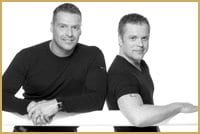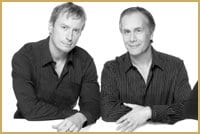
Credit: David Ellingsen photo
Have you ever noticed that there’s something about aging in our gay culture that bends time?
Gay men go along for years being ‘young,’ inordinately longer than our straight friends, and then one day we wake up… not. One day you’re a gayboy, the next you’re ‘older.’
Last year at 44 I was, in my mind, not old. This year I still feel young but, turning 45, I’m guessing I’m not.
People have started calling me “sir.” One night I went to bed with a firm jaw line, the next morning I had jowls! There’s the spare tire that I’ve battled with for years. And worst of all-two months ago I was handed a prescription for bifocals!
“Have a great day,” they said as I left the eyeglasses store.
Peering at the world through new lenses got me thinking.
Age is a topic of immense interest with gay men of all ages, becoming a major preoccupation around the dreaded 30-year mark.
By the time 40 rolls around, the fight against signs of age, and thus potential irrelevance, becomes paramount.
If North American culture has become acutely youth-centric, the gay community has always been. We try our best to remain young through sheer will, hard work and simple refusal. Because our age is our currency: it is the basis for where we fall in the pecking order, like what money stereotypically does for straight men.
Used to cruising our entire lives, either for sex or just for eye candy, gay men have learned to instantly categorize other gay men: twink, leather, bear, fem, daddy, gym-bunny, eastside, West End, did him, didn’t yet, want to, wouldn’t. We also know where we fall in these categories, and shifting into a new one can be discomfiting.
In talking about it with friends around my age, I’ve discovered it’s not the getting older that actually bothers anyone too much-it’s the fear of getting ugly. The fear of becoming invisible or unattractive, and then realizing one day that you’re taking up valuable space at the epicentre of most early gay social life, the dance bar.
Gay men hold power in the first half of life. At least the power we’re most keenly interested in.
My friend Michael Hassard, the manager of a popular West End restaurant, states what we all know deep down: “It’s about sex, stupid.”
At 39 and single, Hassard says, “Everyone tries to slow down the aging process because it’s pretty clear that youth is what everyone wants.”
Youth is the definition of beauty. But even looking young has become a moving target.
To be considered attractive in the gay community once meant having a nice face and a decent basket. Twenty-five years ago, nobody I knew even considered lifting weights, never mind shaving their armpits.
Then in the early 1980s, the Calvin Klein underwear ads and the Soloflex man came along at about the same time the AIDS crisis began.
There was a paradigm shift in the way we saw ourselves as gay men. By the end of the decade, that nice face needed to be atop a godlike body to be considered hot.
It started out with the need to look healthy within the gay community. The ideal hypermasculine clone look of the ’70s of moustaches, plaid shirts, boots and tight 501s, evolved into the even more masculine gym body, suddenly made to seem youthful through the removal of body hair and careful correction of imperfections.
Not everyone bought into this of course. But the general thrust seemed to be if you wouldn’t (or couldn’t) become godlike, at least avoid looking skinny (indicating HIV), and for heaven’s sake don’t get fat-the ultimate gay faux pas.
Drew Dickinson, a realtor of 48, who in the ’70s and ’80s was arguably Vancouver’s best drag performer, believes AIDS “formed the whole psyche of our generation,” and likely the generation that followed.
“We needed to look healthy-people were dying around us,” he says.
That need has evolved into what we see today, he continues, a culture that lifts health and youth to a higher pedestal than ever before.
james Bailey, a Vancouver hairdresser for over 30 years and part-time actor, says he has noticed the biggest change in men’s attitudes toward their appearance in the last five to 10 years.
“Yes, there is an obsession with youth amongst gay men. Was it always like this? I don’t know, but images in magazines and movies have definitely intensified it. Endless makeover reality TV shows don’t help, either.”
To be sexually active and older in the midst of all this is difficult, he notes.
To Talon Thompson, a 41-year-old gay man with a partner of 48, “growing old gracefully is a cop-out.”
That’s just a euphemism for “growing old lazily,” he says.
Age is no excuse for letting your health and appearance slide, he maintains. “Men are not the same 40 as they remember their dad to be. Gone is the wrinkled, beer-bellied 40-year-old, and in is the lean and healthy 40.”
If there is an obsession, it’s to look and be healthy inside and out, he continues. “No one I know wishes to be younger. Men are proud to be in their 40s and look fantastic.”
Thompson has no qualms about admitting he’s had cosmetic surgery and may have more again in the future. His surgery was to correct something he was unhappy with, he says, not to look younger or like someone else. “Nobody wants to look like Joan Rivers-but Joan Rivers!”
Thompson says plastic surgery and Botox and other treatments are no longer a taboo topic.
“A trip to the doctor for Botox is like a trip to the bar. You would be surprised just how many of your friends you run into there.”
He adds, “When you feel good you look good-confidence is sexy. Sex is part of our being and age should not be a barrier.”
Hassard’s tactic for beating back time is Botox injections two or three times a year for the past three years. The investment of about $1,000 a year for the treatments is well worth it, he says, as he no longer has a deep “angry line between my eyebrows” and those three horizontal forehead wrinkles that aged him. “Now I look like I’ve been on vacation for three weeks!”
One of his ex-partners introduced him to cosmetic surgery after he got chin and cheekbone implants and an eyelift while they were together. “It made him happy and he looked better,” says Hassard who, asked if he could see himself having surgery down the road, replies with an enthusiastic “yes, Yes, YES!”
Still, he warns people not to start down this road too early. At 30, he talked with a plastic surgeon about an eyelift but was turned down.
“He could have easily taken my money and given me what I wanted, but he explained that there was no compelling reason at that stage to do it, and if I did, I would be putting myself on a cycle of needing it every five years to maintain the same look.”
Bailey is surprised when I ask him what he does to maintain his looks.
At first he denies doing anything. But when pressed, he admits that a lot of little things have become part of his routine. Regular trips to the tanning salon (also apparently like a gay bar at times, he says); hair colour (“who doesn’t these days?” he asks); skin care; eyebrow plucking; body hair removal; cosmetic dental work; regular clothes shopping, etc.
Dickinson readily admits to that pre-Botox fixer-upper, collagen, for forehead frown lines a few years ago. As well, he’s had all his teeth capped, done originally for the stage in bright white, but recently redone in natural colour.
Do straight men care as much about their appearance and have physical enhancements done too?
You bet, says Mark Cooperstone, 41, who co-owns a spa in Yaletown. “Gay men have taste, style, personality, and straight men see that and strive for it too.
“Gay or straight, men are really into the benefits of maintaining youthful, healthy appearances, through facials, microdermabrasion, Botox, massage,” he continues. “It allows all men the opportunity to grow older and continue to feel good about themselves.”
With straight men taking better care of themselves, working out, using skin products, going to spas and seeing plastic surgeons-“It’s really screwing up our gaydar,” laughs Thompson.
is it possible that what may seem like an obsession with youthful looks is really just common sense, a way of prolonging our sexual attractiveness beyond that narrow strip of youth?
“If there has been a shift in thought, it’s that we’re realizing that being 40 doesn’t mean losing your sex appeal,” says Thompson.
With a little effort at self-improvement, “in many cases, men are looking better in their 40s than they looked in their 20s and 30s,” he says.
Recently, Dickinson noticed something slightly startling: he’s discovered he’s become somewhat of “a commodity” again now that’s he’s older.
Physical signs of aging like crow’s-feet and greying hair hint at knowledge and experience, he guesses. In any case, “I’m getting hit on again!”
Who knows how long it will last, he says, “but it’s a reprieve” that’s as delightful as it is unexpected.
Bailey points to other potential compensations for the piling up of years. The phenomenon of male attention to appearance is great for his business, he says, noting that there are as many men as women that go to salons now and buy just as much product.
More significantly, despite the fact that aging in a youth culture can be challenging for one’s sex life, he has never been happier with himself now that it’s easier to be gay in a much more accepting society. “Gay kids have no idea what it was like just a few years ago,” he says.
What all five agree on is that it’s not necessarily chasing after looking young that’s important, but rather to look your best, regardless of your age.
Dickinson says there’s a difference between grooming to look your best and trying to look younger. “Trying to look younger usually just makes you look ridiculous.
“Being attractive when you’re young is easy,” he continues. “When you’re not young anymore, you need to find ways of feeling good about yourself, because self-confidence is what’s truly attractive no matter what your age.”

 Why you can trust Xtra
Why you can trust Xtra


